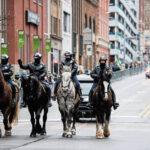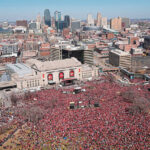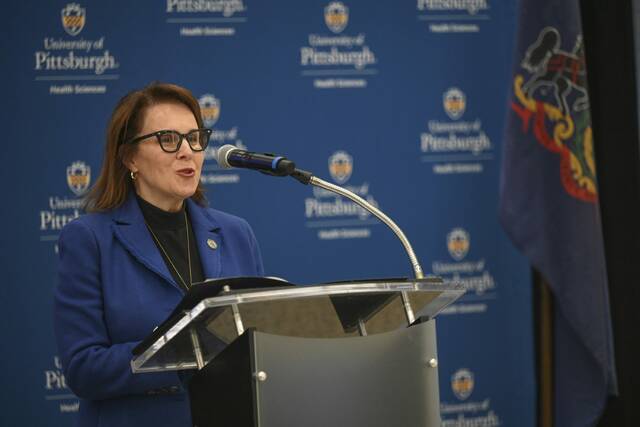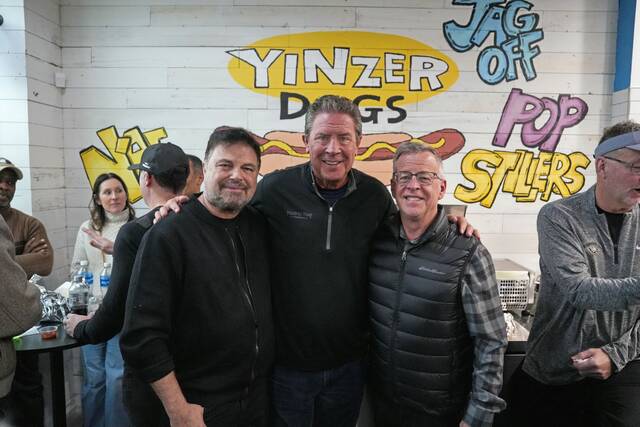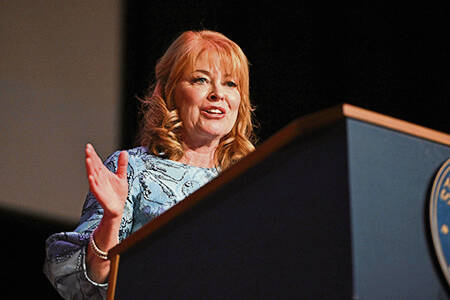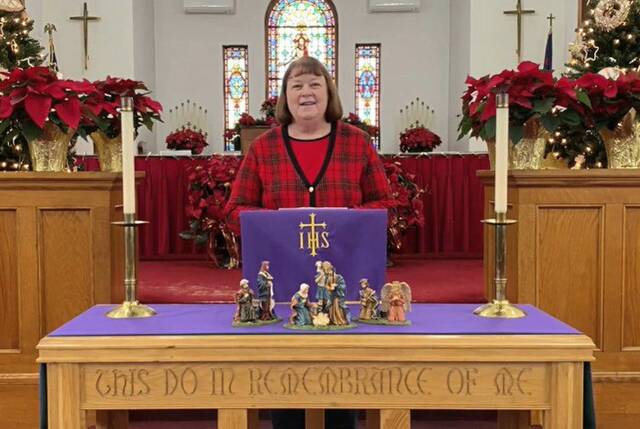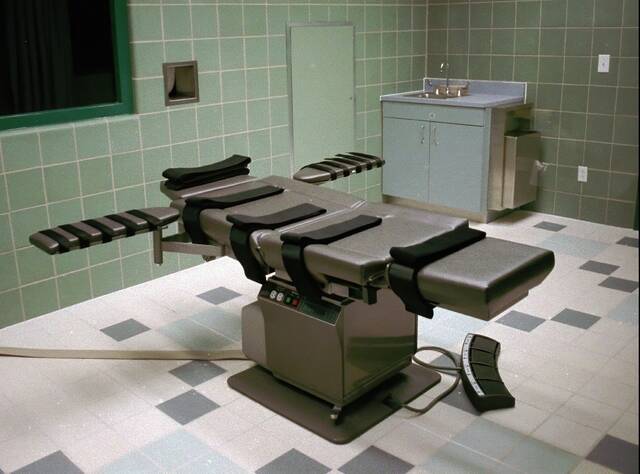When news broke on Jeff “Mac” McCafferty’s TV about the Kansas City Super Bowl parade shooting, the retired Pittsburgh Public Schools history teacher instantly thought of two things.
Pittsburgh.
And St. Patrick’s Day.
The longtime St. Patrick’s Day Parade chairman has for eight years helped organize the city’s largest annual single-day event. In good March weather, more than 300,000 Pittsburghers fill Downtown for the parade.
“Anytime that anything like (the Kansas City shooting) happens, hopefully everybody has a reaction to it,” said McCafferty, 65, a Carrick native who lives in Swisshelm Park. “I thought of it like anybody. But since I’m heading this parade, it perked up my ears.”
“It can happen anywhere,” said the 33-year teaching veteran and football coach, who has been volunteering on Pittsburgh’s St. Patrick’s Day parade committee for 25 years. “It can happen in a house of worship. It can happen in a school. It can happen in a grocery story. And none of those people expected it to happen.”
McCafferty’s reaction is reasonable, according to experts who feel law enforcement can learn more about policing outdoor or public-facing events in cities through incidents like the shooting at the Kansas City parade.
The list of similar events in metropolitan areas includes the 2017 mass shooting at a Las Vegas Strip music festival, where more than 1,000 rounds shot from a hotel window killed 60 and injured at least 413.
Since the Sept. 11, 2001, terror attacks, police and security teams have tried to thwart violence at these kinds of events by strengthening event perimeters and using more metal detectors and body scanners, said Alex Piquero, whom President Joe Biden appointed to head the federal Bureau of Justice and Statistics in 2022.
Many agencies, such as Pittsburgh police, strategically place and employ video cameras throughout their respective cities and use sometimes-controversial gunshot detection systems, Piquero said. Others patrol events with drones.
“This is the cost of living in this country,” said Piquero, a criminology professor for 26 years, most recently at the University of Miami. “This is about keeping public safety … and we’re put into this position by people with armaments and nefarious intentions.”
Gun deaths among children and teens nationwide rose 50% in just two years, from 1,732 in 2019 to 2,590 in 2021, according to mortality data from the U.S. Centers for Disease Control and Prevention. About 4 in 10 U.S. adults live in a household with a gun, according to a Pew Research Center study from June.
It’s unclear if Pittsburghers can expect changes for the St. Patrick’s Day parade next month. Pittsburgh police Chief Larry Scirotto and public safety director Lee Schmidt declined to discuss it Friday with TribLive.
Mayor Ed Gainey could not be reached for comment.
“I can tell you that the Department of Public Safety continually prepares for mass events in the city, meeting weekly with partners to discuss security and staffing for upcoming local events,” police spokeswoman Cara Cruz said in a prepared statement.
“As well, the Pittsburgh Police Intelligence Unit regularly coordinates with partners in other cities on an ongoing basis, especially following tragic events like the one in Kansas City, to ensure Pittsburgh is preparing for as many contingencies as possible and learning about any security blind spots or emergent threats,” she added.
Safety issues at outdoor events resonate beyond Pittsburgh — well into the scores of smaller communities and counties that surround it.
Thousands, for example, flock each year to Memorial Day celebrations in Lower Burrell.
“Events such as Kansas City serve as tragic reminders that we have to do everything in our power to ensure that those events are held as safely as possible,” said Chris Fabry, Lower Burrell’s newly elected mayor.
Parades a challenge for police
Authorities on Friday said two juveniles were detained on gun-related and resisting arrest charges in connection with the shooting Wednesday outside Kansas City’s historic Union Station. Jackson County Family Court said more charges are expected, pending a continuing investigation by Kansas City police.
One woman was killed in the shooting and 22 people were injured. The victims ranged in age from 8 to 47 and half of them were younger than 16, police Chief Stacey Graves said at a news conference Thursday.
The shooting happened despite the presence of more than 800 police officers. Police in Kansas City say a dispute may have led to the shooting.
Brian Higgins, a former Bergen County, N.J., police chief who worked just miles from where the World Trade Center was felled in 2001, said it’s tough to pick apart Kansas City’s safety mechanisms because the shooting “is not an incident that occurred related to the event.”
“It’s as if you went to Three Rivers Stadium and there’s a shooting in the parking lot or across the street,” said Higgins, a lecturer for seven years at John Jay College of Criminal Justice in New York. “There’s definitely levels of security and screening measures. … Any measures they had in place would’ve made a difference. In an urban environment, this is hard to do.”
Parades, with their moving borders, are especially tough, although some guidelines from federal officials have helped greatly, Higgins said. Federal homeland security standards now require a certified crowd manager when events draw at least 250 people.
The federal government also has a group dedicated to such events: the Cybersecurity & Infrastructure Security Agency. Officials there work with police, emergency managers and other first responders to prepare for “large-scale, public-facing events,” according to the federal Department of Homeland Security.
“CISA’s role is to provide support to the local and state officials through resources such as security briefings, assessments, training, exercises and on-site support,” said Bill Ryan, director of CISA in Region 3, which includes Pennsylvania.
In addition to helping gauge potential threat levels through a Special Event Assessment Rating scale, CISA provides event organizers and law enforcement with resources such as its Mass Gathering Security Planning Tool, Ryan said.
NFL safety examples
Since the Sept. 11 attacks, organizations such as the NFL have been ahead of the curve and “done a really good job at ramping up security,” Higgins said.
Though NFL policy “strongly encourages fans not to bring any bags” into stadiums, the league was the first to employ a clear-bag policy, said Tim Schlittner, the NFL’s communications director. Many concert venues throughout the U.S. followed suit.
Today, only small bags that are clear plastic, vinyl or PVC are permitted at NFL games and events.
NFL events are massive security operations, Schlittner said. An estimated 100,000 people went through the Super Bowl Experience, a kind of interactive exhibit staged in Las Vegas, in the four days leading up to the big game.
“Our security plans are refined years prior to an event,” Schlittner said. “And we’re always evolving.”
The incident in Kansas City “was not related to the parade,” Schlittner stressed.
“It was a dispute between two people,” he said. “But any learning we can take from that, we will.”
Advanced technology also helps.
The Massachusetts-based security firm Evolv — cited by Higgins and others — has developed “touchless” security screening technology, like metal detectors that scan patrons without requiring pat-downs or emptying of pockets.
Evolv advertises that the technology, some of which uses artificial intelligence, has screened more than 60 million people — second only to the Department of Homeland Security’s Transportation Security Administration.
The company did not respond to phone calls or emails Friday seeking comment.
Pittsburgh’s parade
Pittsburgh’s St. Patrick’s Day parade has faced several obstacles since it became an annual event in 1954.
The parade has beaten them all, McCafferty said with a laugh.
McCafferty remembers the March 13, 1993, blizzard that dumped a single-day record of 23.6 inches of snow on Pittsburgh. And there were the security details necessary in the 2000s for then-Vice President Joe Biden and then-U.S. Sen. Hillary Clinton to walk alongside Pittsburghers in the parade.
In March 2020, during the early days of the covid-19 pandemic, Mayor Bill Peduto tried to cancel the parade as a precautionary measure to prevent the potential spread of the coronavirus.
McCafferty joined about 100 people to walk the parade route anyway — complete with city police and rolling road closures. Some businesses continued to operate. The Monday after the weekend parade, Pittsburgh started to prohibit gatherings of more than 250 people.
“St. Patrick’s Day is a day for the city to come together as a community and celebrate being Pittsburghers,” said McCafferty, who moonlighted as a bouncer at Froggy’s after playing football at Lincoln University of Missouri. “It’s a tradition in Pittsburgh. And I don’t think we want to get rid of tradition.”
McCafferty doesn’t think the Kansas City shooting will impact the 2024 parade in Downtown Pittsburgh.
“Unfortunately, it’s a little early for me to start worrying. We’ve had how many shootings this year, and it’s only Feb. 16?” he said. “We’ll probably have another 40 before St. Patrick’s Day.”
There were 2,021 shootings, injuring 3,437 people, in the United States as of Friday, according to the Gun Violence Archive, an online database. Fifty of those were deemed “mass shootings.”
On March 16, the date set for this year’s parade, McCafferty expects police and public safety officials to close off the same roads and control crowds by mounting “bicycle fencing” — a kind of metal barricade Pittsburgh started using for the G20 summit in November 2008.
He’s more concerned with a child breaking away from family and running in front of a fire truck than someone opening fire on the Boulevard of the Allies.
City Councilman Anthony Coghill said big-crowd events like the St. Patrick’s Day parade heighten his concerns about police staffing levels.
Scirotto told councilmembers during a Thursday meeting that the police force is down to 743 officers, Coghill said.
“That’s a scary number for big events,” Coghill said.
The force — which Gainey budgeted for a staff of 850 this year — could drop below 700 by the end of 2024, the councilman said.
“(Safety) is always on our radar, whether it’s a parade or big sporting events,” said Coghill, council’s public safety representative, who lives in Beechview.
Councilwoman Theresa Kail-Smith is less concerned than Coghill about the parade. She said state police and Allegheny County Sheriff’s deputies will help control the crowds.
“I think they’re doing a lot of things currently, but I’m worried about the summer. I’m worried about tomorrow. I’m worried about tonight,” said Kail-Smith, whose district includes the West End. “I’m not comfortable with this number of (city police) officers.”
Piquero, the criminology professor, said the numbers might not be the biggest factor in the safety of the event.
“What I don’t want is people to not live our lives,” he said. “I would encourage anyone to go to a parade … but no amount of preparation is going to prevent something like this.”
Small-town safety
Incidents at outdoor events are not isolated to urban areas.
In December in Freeport — population in 2020: 1,736 — an Armstrong County man who was Tasered twice after a high-speed chase said he sped off because he didn’t want to wait in traffic for the borough’s Christmas parade.
An elected leader in Lower Burrell once dubbed his hometown “Parade City USA” because the city still held parades during the pandemic — even launching a new one for St. Patrick’s Day. Lower Burrell’s Memorial Day parade, an Alle-Kiski Valley tradition for at least 50 years, draws thousands to the Westmoreland County hamlet.
Events like that take time and planning locally — and Fabry, who was sworn in to his first term Jan. 3, wants to expand the network of planners to state and county agencies, as well as surrounding municipalities.
“I have always been a believer that you cannot live your life in fear,” Fabry said. “We still have a responsibility to provide the public with events and things to do.”
Ray Werner knows about small towns.
The playwright and retired advertising executive lives in North Oakland, but he grew up in Freedom, a Beaver County mill town along the Ohio River. In Werner’s younger days, about 3,000 people called Freedom home.
Werner’s great-grandmother left Ireland’s County Donegal — the Irish put the stress on the last syllable — in 1847 at age 17 and settled with her family near Derry, Westmoreland County. Nearly 180 years later, in 2023, Werner served as grand marshal of Pittsburgh’s St. Patrick’s Day parade.
“It was a day to celebrate, but for me it was people coming together,” said Werner, 85.
Werner isn’t worried about the parade in light of what happened in Kansas City. He said that in recent years, public safety and even local businesses have done a good job controlling parade revelers who drink too much alcohol.
“Pittsburgh is a great city,” he said. “We have to make Downtown a little safer. I think it’s safer on St. Patrick’s Day than it is any weekday of the year.”





